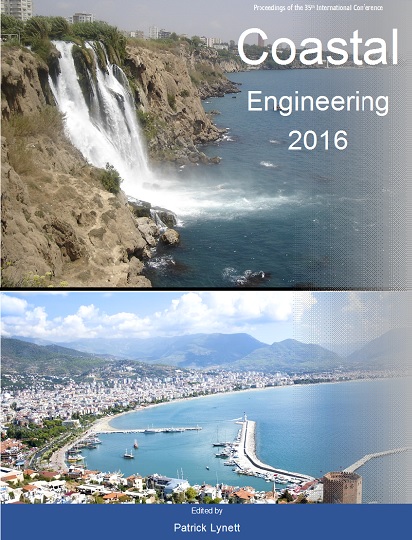Abstract
This paper presents a coupled wave-vegetation interaction model suitable for very flexible vegetation with large deflections. The wave hydrodynamics is modeled by a Navier-Stokes flow solver along with a Volume of Fluid surface capturing method. The governing equation for flexible vegetation motion is solved by a Finite Element Method using a semi-implicit time differencing scheme. The coupling between wave hydrodynamics and vegetation motion is achieved using an immersed boundary method. The model is validated with experimental measurements for a single-stem vegetation and a large-scale vegetation patch in a wave flume.References
Abdelrhman, M.A. 2007. Modeling coupling between eelgrass Zostera marina and water flow. Mar. Ecol. Prog. Ser. 338, 81-96.
Chen, H., S. Xu, and H. Guo. 2011. Nonlinear analysis of flexible and steel catenary risers with internal flow and seabed interaction effects. Journal of Marine Science and Application, 10(2), 156-162.
Christensen, E.D. 2006. Large eddy simulation of spilling and plunging breakers. Coastal Engineering, 53 (5-6), 463-485.
Garrett, D.L. 1982. Dynamic analysis of slender rods, Journal of Energy Resources Tech., 104(4), 302-306.
Higuera, P., J.L Lara, and I.J. Losada. 2013. Realistic wave generation and active wave absorption for Navier-Stokes models: application to OpenFOAM. Coast. Eng. 71, 102-118.
Li, C.W., and K. Yan. 2007. Numerical investigation of wave-current-vegetation interaction. J. Hydraul. Eng., (2007)133:7(794), 794-803.
Lin, P.Z., and P.L.-F. Liu. 1998. A numerical study of breaking waves in the surf zone. J. Fluid Mech., 359, 239-264.
Lin, P.Z. 2007. A fixed-grid model for simulation of a moving body in free surface flows. Computers & fluids, 36(3), 549-561.
Lubin, P., S. Vincent, S. Abadie, and J.P. Caltagirone. 2006. Three-dimensional large eddy simulation of air entrainment under plunging breaking waves, Coastal Engineering, 53, 631-635.
Lv, X., Q.P. Zou, D.E. Reeve, and Y. Zhao. 2009. A novel coupled level set and volume of fluid method for sharp interface capturing on 3D tetrahedral grids, Journal of Computational Physics, 229(7), 2573-2604.
Marsooli, R., and W. Wu. 2014. Numerical investigation of wave attenuation by vegetation using a 3D RANS model. Advances in Water Resources, 74, 245-257.
Maza, M., J.L. Lara, and I.J. Losada. 2013. A coupled model of submerged vegetation under oscillatory flow using Navier-Stokes equations. Coast. Eng., 80, 16-34.
Peskin, C.S. 2002. The immersed boundary method. Acta numerica, 11, 479-517.
Ran, Z. 2000. Coupled dynamic analysis of floating structures in wave and current. Ph.D thesis, Texas A&M University, College Station, TX.
Stratigaki, V., E. Manca, P. Prinos, I.J. Losada, J.L. Lara, M. Sclavo, C.L. Amos, I. Caceres, and A. Sanchez-Arcilla. 2011. Large-scale experiments on wave propagation over Posidonia oceanica. Journal of Hydraulic Research, 49, 31-43.
Wang, Z.Y., Q.P. Zou, and D.E. Reeve. 2009. Simulation of spilling breaking waves using a two phase flow CFD model, Computers & Fluids, 38 (10), 1995-2005.
Weller, H.G. 2002. Derivation, modelling and solution of the conditionally averaged two-phase flow equations. Technical Report TR/HGW/02, OpenCFD Ltd.
Zhang, Y.L., Q.-P. Zou, D. Greaves, D. Reeve, A. Hunt-Raby, D. Graham, P. James, and X. Lv. 2010. A level set immersed boundary method for water entry and exit. Communications in Computational Physics, 8(2), 265-288.
Zhu, L., and Q. Chen. 2015. Numerical Modeling of Surface Waves over Submerged Flexible Vegetation. Journal of Engineering Mechanics, A4015001.
Zou, Q.-P., and Z. Peng. 2011. Evolution of wave shape over a low-crested structure, Coastal Engineering, 58(6), 478-488.

